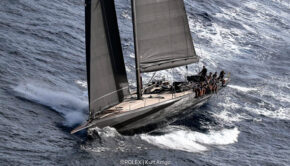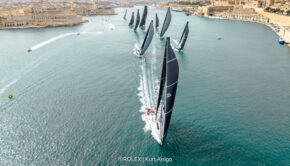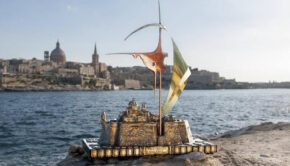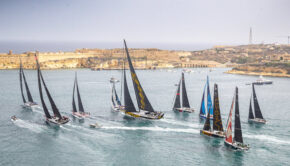How the race was won (with amateurs)
Published on November 3rd, 2014
The Rolex Middle Sea Race course, a 608 nm route circumnavigating Sicily and its neighboring islands, set out with a record fleet of 123 entries on October 18. Christian Ripard, co-skipper of the overall winner J/122 Artie, shares how they took the title with an amateur team…
I like offshore racing with my friends and family, as it’s more of an adventure and challenge, rather than when doing it professionally. Both have their advantages and disadvantages but both are demanding in terms of boat prep and individual crew contribution. All in all, they are both similar in terms of work demands and crew commitment.
Obviously when doing it as a professional one must excel in their designated role and is expected to do the job to the best of their ability, as a pro. When one does a campaign as an amateur, then another dynamic is introduced …. passion.
So when we started this year’s race, all were doing it with great passion to win as amateurs. All are good sailors but more importantly all are mariners with seamanship in their blood, experienced to handle whatever we would get.
From the start, the frame of mind on board was of a very focused team. We knew that this year our competition was even greater than ever before and that we’d have to work hard to secure a decent result.
The first leg to Sicily was a race with no overtaking zones and we found early that our main competition Otra Vez (another J/122 with the exact same rating!) was being sailed very well. On reaching the southeastern most tip of Sicily, the fleet was split into three main groups that where to the west, middle and east of the rumbline. Otra Vez was in the middle group and us in the east group. As the sun went down the wind died for all yachts but started favoring the middle group and who quickly made large gains on the other two groups (west and east groups).
After a painful two hours looking at OV disappear over the horizon we were now ten miles behind them before we finally got into the same breeze. This was a blow to us and we knew, it would be hard to regain, especially as OV was sailing as fast as we were.
This pushed us to concentrate hard at keeping the boat moving (only 3 knots of wind!) and at getting all the ‘shifts’ right. By morning we had closed to gap (behind OV) to six miles and were moving better than a lot of boats around us, in the light downwind conditions.
By the time we got to the Messina Straits we had closed the gap to three miles and getting closer with every gybe. On exiting the straits we found a large number of yachts (approx. 70) spread wide from east to west covering a large area all trying to get the best angle to Stromboli….us still light running downwind with our A1 asymmetric and still gaining.
The leg to Stromboli is crucial and big gains can be made…if you read the signs correctly…which we did very well and calculated that we actually overtook around 60 yachts by the time we got to Strombolicio (the turning point), and only one hundred meters behind Otra Vez. We had gained the ten miles we lost in 24hrs!
At this stage we also knew that the next longest leg to Capo San Vito would be the race decider and worked very hard (very little sleep) to keep the boat moving and head northwest for the forecasted North-Westerlies due to arrive in 30 hrs.
With good crew work (skill) and constant watch on our competition we edged forward on the fleet albeit very slowly to gain a few crucial miles on our nearest rivals on the water….a TP 52, Swan 82, Marten 49 and five other larger race yachts, so that when the first little signs of the NW came we started multiplying our advantage with every minute and gained enough on Otra Vez to round C S Vito fifteen miles ahead and also leading all the Class 3 yachts (we are Class 4) as well, boat for boat! This was our winning move.
Once we rounded Favignana we had 25knots TWS at 120 TWA and started to put on the miles on our competition. The lead we had of fifteen miles translated to around 35/40 miles in front of Otra Vez and counting by the time they rounded the corner behind us.
The advantages of having a talented and experienced crew is that when we did get the breeze (40 to 50+ TWS) and large seas (8 to 10 meters), we handled the boat without any dramas and/or damage, only ripping the JT out the foil twice and broaching (a few times!) plus losing our wind instrument at the top of the rig, only to settle down with our storm jib and two reefs in the main (still over powered at times!) and be sure that we did actually finish the race. We did not have to push the boat but we were still racing and didn’t actually know at the time that we were hours ahead of all our competition.
Basically we sailed from Favignana to the finish line in 25hrs…nearly half the race. Not bad going for a bunch of amateurs!
Artie’s winning team – RMSR 2014
Lee Satariano
Christian Ripard
Sebastian Ripard
Tim Davis
Tommy Ripard
Mathieu Almekinders
Matthew Gusman
Sam Pizzuto
Gordon Bugeja
If you don’t have a good team, you just won’t get through it or you will break things and when it comes down to it, this team proved excellent.”
Video of J/122 Artie in the Med
NOTE: This was Christian’s fourth Overall Rolex Middle Sea Race win, taking the title previously in J/105 Bigfoot (1996), J/125 Strait Dealer (2001), J/122 Artie (2011) and again J/122 Artie (2014).









 We’ll keep your information safe.
We’ll keep your information safe.